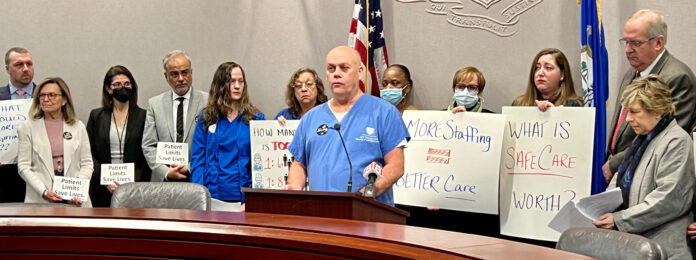Tireless advocacy by members of AFT Connecticut-affiliated healthcare unions paid off earlier this year when state lawmakers adopted stronger hospital staffing requirements. Following the governor’s signature in June, the new “safe patient limits” law’s mandates were effective on October 1. AFT Connecticut Vice President John Brady, RN (at podium in photo, above), shared the story of this “game changer for recruitment and retention” among nurses and health professionals in a recently published commentary:
In Connecticut, we’ve been fighting for safer healthcare workplaces for decades. We’ve had some successes, but AFT Connecticut members continue to face working conditions that threaten their safety and the safety of their patients.
The staffing legislation we’ve had in place in the state since 2009—which was updated in 2015—was insufficient to address the problem. It called for staffing committees and a collaborative process to develop staffing plans, but it didn’t require those committees to approve the plan. Management showed a plan to the committees and claimed collaboration. And some of our hospitals were still mandating overtime despite Connecticut’s law against it, using a loophole to require nurses to work past their assigned shifts.
As consolidation has increased in our state, staffing shortages that were already dire have only gotten worse.
Click here for a local union leader’s published commentary on the crisis from earlier this year.
We needed to create real change in our members’ workplace conditions, so we established six goals for our multiyear Code Red campaign:
- Pass legislation on staffing and mandatory overtime;
- Fight for staffing and safety concerns through collective bargaining agreements;
- Build internal organizing power and structures for member and community engagement;
- Increase AFT Connecticut’s impact as a leader on Connecticut healthcare issues;
- Be the union that nonunionized healthcare workers look to when they’re ready to fight for change; &
- Continue our work with other unions and affiliates across the country.
We began with our legislative goal: statewide staffing ratios and strengthened protection against mandatory overtime. We wrote a bill using the federal Nurse Staffing Standards for Hospital Patient Safety and Quality Care Act as a template, then proposed it to the chairs of the public health committee in our state legislature.
Forty AFT Connecticut members testified at the public hearing on the bill, and many others submitted written testimony.
Click here to watch highlights of healthcare union members’ testimony.
After some pushback on the ratios, the bill died in the judicial committee. But, in a major victory, an adjusted version was passed after it was added to the budget implementer bill.
Getting the staffing bill into the budget implementer bill took bipartisan support. A group that included our lobbyists, one of our field reps, and the Connecticut Nurses Association met with Republican and Democratic leaders of the public health committee, a few state agencies and the governor’s office. We discussed the problems some committee members had with the bill and hammered out a version that both houses of the legislature agreed on.
Click here for press reporting on passage of the final legislation.
One of our Republican state senators helped strengthen the legislation in a big way. To replace the ratios, we proposed staffing committees in which half of the members were bedside nurses. Foreseeing potential ties between staff and management, this senator insisted that the number of bedside nurses be 50 percent plus one.
So what passed in the end is a game changer for recruitment and retention. Now, the law effectively addresses mandatory overtime, the majority vote on our staffing committees will always belong to bedside nurses, and staffing committees will approve any staffing plans. In union hospitals, the union picks the nurses on the committee, so if we do this right, we should be able to write our hospitals’ staffing plans, including the ratios, which will be enforced by the Department of Public Health with fines.
Click here for a document highlighting the new law’s major provisions.
In time, others will see the power of that union difference. It’s going to take a lot of work to make sure that this legislation and our staffing committees are effective. Over the next months, we’ll be educating our members about the new bill and training new staffing committee members. Those chosen to be on staffing committees are going to be very important; they need to know how to be strong (so they don’t get pushed over by management) and how to vote as a caucus.
Click here to watch the latest training session on effective implementation of the new law.
We achieved our legislative goal much faster than expected, and the internal and external organizing and coalition building we’ve engaged in over the last decade were the foundation for this victory. Currently, 24 of our 36 state senators are Democrats; of those, 9 are union members and 2 are AFT members, including our state federation president, Jan Hochadel. That’s the result of years of door knocking, getting people out to vote, encouraging participation in member organizing institutes, and other strategies. All of these efforts compound over time.
We’ve made great progress on all of our campaign goals. And we’ll keep reevaluating and collaborating with our local leaders and affiliates to make sure we’re all going in the right direction, sharing resources and lessons learned so that our successes build off each other. We have high hopes that through our examples, hospitals nationwide will be compelled to do right by their workforces.
Click here for Brady’s original commentary published in AFT Health Care.



